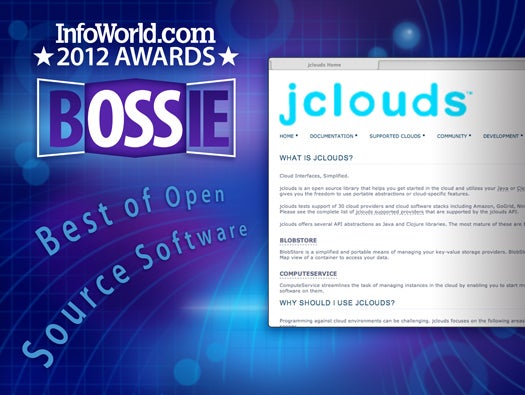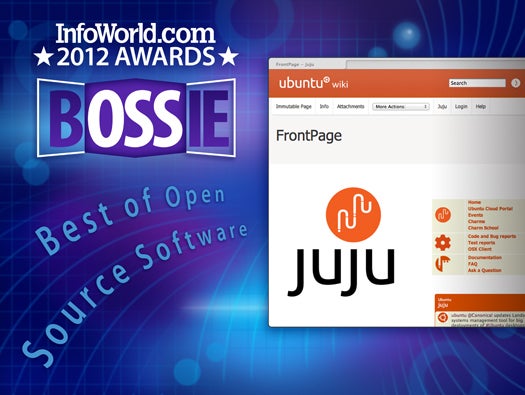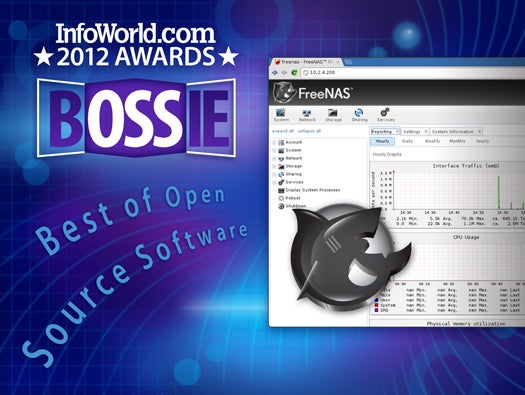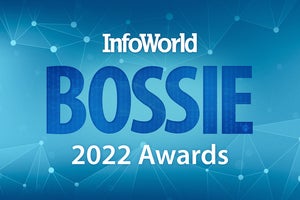Bossie Awards 2012: The best open source data center and cloud software
InfoWorld's top picks in data center and cloud storage, virtualization, and cloud service management

The best open source data center and cloud software
The data centers of tomorrow will be vastly more flexible and dynamic than the data centers of today, and these Bossie winners -- some of the fastest-moving projects we know -- will be the software that takes us there. But along with free open source tools for building and automating virtualization clusters and private clouds, you'll also find some old favorites here.

OpenStack
The OpenStack cloud computing project was started by NASA and Rackspace Hosting, and in almost no time at all gathered the support of every technology company that fears Amazon in the cloud. Today, even VMware has a finger in this pie. OpenStack follows the Amazon cloud services model (EC2 plus S3) and provides an Amazon-compatible API to compute and storage services. OpenStack's dashboard gives administrators control over cloud resources while providing end-users an easy self-service portal through which to provision their VMs and storage. The imminent Folsom release extends management to virtual network infrastructure like Open vSwitch.
-- High Mobley

CloudStack
CloudStack is the ball that Citrix brought to play with OpenStack, then took back home. Then Citrix handed CloudStack to the Apache Foundation for independent governance as open source software. CloudStack is well-positioned for use by service providers. It features a great Web UI for administering cloud resources, as well as a brandable end-user interface. It also uses the concept of domain admins, who sit between the admins and the end-users, making it suitable for use by resellers. CloudStack provides an Amazon AWS compatible API with full support from Citrix. Notice a trend here?
-- High Mobley

Eucalyptus
The Eucalyptus cloud computing project aims to provide API parity with Amazon Web Services. Amazon itself has thrown its weight behind the Eucalyptus project, officially endorsing Eucalyptus' use of the AWS APIs. This makes Eucalyptus a logical choice for organizations that need to run public/private hybrid cloud services, and its integration with the RightScale myCloud service gives administrators a single tool to control this new hybrid cloud setup. Eucalyptus has been in the private cloud business since before anyone uttered the words "private cloud." It may very well be the most widely deployed of the open source cloud computing projects.
-- High Mobley

Ganeti
Developed by Google, Ganeti is a management tool for small clusters of virtualization servers running Xen or KVM. It supports setting up instances using a file, an LVM volume, or a DRBD mirror. Ganeti can do live migrations of instances from one server to another, and unlike other budding "cloud controllers," it provides real HA fail-over versus rebooting lost VMs elsewhere on the cluster. However, only local storage is supported. If you're interested in Ganeti, you should also have a look at a separate project called Ganeti Web Manager, which provides a good Web UI on top of the management system. A private cloud operating system from Google -- who knew?
-- High Mobley

Open vSwitch
An open source distributed virtual switch that stands shoulder to shoulder with those in vSphere 5 and Hyper-V 2012, Open vSwitch is used in Citrix XenServer and the Xen Cloud Platform, and it supports Xen, KVM, and VirtualBox. With advanced flow monitoring, vprobes, spans, QoS, and the ability to deploy as a virtual or physical appliance, Open vSwitch's features list is more impressive than some hardware switches! You'll find NetFlow, sFlow, 802.1ag, LACP, SPAN and RSPAN, QoS, several tunnel protocols, 802.1q VLAN tagging, OpenFlow support, and traffic control on a per-virtual-interface basis.
-- Brian Chee and High Mobley

Cloud Foundry
Platform-as-a-service offerings tend to restrict choices of frameworks, application services, and clouds. Open source Cloud Foundry has no such restrictions. It supports a wide range of services, and it integrates with many clouds -- vSphere/vCloud, Amazon Web Services, OpenStack, Rackspace, Ubuntu, and more -- running on private or public infrastructure. There's also the Micro Cloud Foundry, which is completely free and can be deployed on a laptop. Developers can quickly build next-generation applications by writing once locally, testing, scaling, and deploying with no code changes.
-- Deep Mistry

JBoss AS7
Isn't Java EE dead? Apparently not. JBoss Application Server 5 was frankly a bit of a disaster: slow, buggy, and dare I say WebSphere-like in its footprint. JBoss AS 7 starts up faster than Tomcat on my laptop. Jason Greene, the project lead, and the rest of the team are to be commended for making a JBoss that gets back to its roots: It's free and it doesn't suck.
-- Andrew Oliver

Jclouds
While Amazon has been establishing its AWS APIs as the de facto standard for cloud services, Jclouds has been busy making the differences between Amazon's cloud APIs and everyone else's irrelevant. The Jclouds project is a cloud services API abstraction layer, designed to make dealing with multiple cloud services simple and portable and mired in as few dependencies as possible. The Jclouds APIs -- available for Java and Clojure -- can be used to control Amazon Web Services, OpenStack, Eucalyptus, Windows Azure, and many more cloud services. As many cloud computing projects turn to AWS compatibility, while many others, such as VMware, continue going their own way, Jclouds offers a single cloud API to cover them all.
-- High Mobley

Puppet
If you manage a heterogeneous network running various operating systems and want one ring to rule them all, Puppet is your answer. Describe the desired node state with a single high-level language, and Puppet takes care of the rest. It does far more than set up machines and install packages, however. It will also monitor and set things right when that intern decides to make "improvements." Puppet has recently gone RESTful and moved under Apache from the GPL. The 790-member-plus IRC channel is proof that Puppet is strong and growing.
-- Patrick French

Chef
For raw configuration management power, nothing beats Chef. This versatile Ruby-based tool is well positioned to back the most daunting deployment strategies. Chef "recipes" describe a node's packages, configurations, and services. Users can reach for one of the more than 250 cookbooks or whip up a dish of their own using the Ruby DSL. Although Chef will set up a single machine, it really shines in large cloud deployments of more than a couple hundred nodes. Expect new capabilities soon, as the cooks at Chef are busy whipping up support for more platforms and streamlined installers.
-- Patrick French

Juju
What Chef and Puppet bring to system configuration, Canonical's Juju brings to Ubuntu cloud management -- namely a reusable set of resources to bootstrap cloud services and even the servers they're running on. Combining metadata for describing services and scripts (aka Charms) for controlling them, Juju delivers consistent, reproducible service deployment, orchestration, and scaling. Best of all, using Juju is as simple as installing or removing an Ubuntu package. More work is needed on the Charms front. But as more Charms become available, Juju will not only take the tedium out of administering large and dynamic environments, but allow smaller shops to take advantage of the best practices they encapsulate.
-- James R. Borck

GlusterFS
GlusterFS is the distributed file system for commodity hardware. Red Hat purchased the company behind the project last year, and the software seems primed for mainstream usage. It is monumentally simpler to install than GFS2 and a lethal enemy to expensive SANs. Better monitoring tools, documentation, and community involvement would be laudable goals, but with the kind of performance you can get running Gluster on off-the-shelf NAS boxes and some old servers, we can't complain too much.
-- Andrew Oliver and Leon Justice

Ceph
Ceph is a distributed file system that is very well put together and offers everything you need, from basic network storage to high-performance clusters for big data crunching. Anywhere there was a need for NFS can now be fulfilled with CFS. This will remedy all the file lock issues you experienced using the Linux native file system. And Ceph is remarkably easier to install and configure than other cluster-ready offerings. GlusterFS may be the presumptive heir to the distributed file system throne, but with additional maturity, Ceph may establish a dynasty of its own.
-- Andrew Oliver and Leon Justice

FreeNAS
Based on FreeBSD, the open source FreeNAS storage platform has a long list of features that includes ZFS, thin provisioning, remote replication, S.M.A.R.T. monitoring, a comprehensive Web GUI, and support for high-speed networking (10GbE). FreeNAS has done a good job of supporting most popular file-sharing protocols, but is notably missing support for WebDAV, which should be included in the next major release. The current release (8.2) provides a plug-in architecture, with the plug-ins running within a BSD jail for security. There are already plug-ins for BitTorrent, UPnP, iTunes/DAAP, and a Web server.
-- High Mobley

Openfiler
Like FreeNAS, Openfiler supports a variety of SAN and NAS technologies. Unlike FreeNAS, Openfiler is based on Linux and the LVM volume manager, and it contains support for WebDAV. Openfiler can make use of PAM, NIS, LDAP, Active Directory, and other authentication systems. One of the best features of Openfiler is the ability to apply storage quotas on groups as well as individual users, and it can even combine group and individual quota rules.
-- High Mobley

NAS4Free
A spinoff and continuation of the FreeNAS 7 project, NAS4Free is built upon FreeBSD 9.x-RELEASE. There is a mix of reviews with people claiming that FreeNAS or NAS4Free is faster or more stable or has a better Web UI. Try them both and see which one works better for you.
-- High Mobley
Copyright © 2012 IDG Communications, Inc.


















